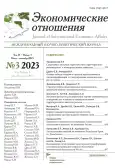Основы выбора секторов и отраслей промышленности для диверсификации и стимулирования экономического роста страны
- Авторы: Дробот Е.В.1, Макаров И.Н.2
-
Учреждения:
- Первое экономическое издательствЦентр дополнительного профессионального образования
- Финансовый университет при Правительстве Российской Федерации (Липецкий филиал)
- Выпуск: Том 13, № 3 (2023)
- Страницы: 393-404
- Раздел: Статьи
- URL: https://journals.rcsi.science/2587-8921/article/view/146678
- DOI: https://doi.org/10.18334/eo.13.3.118740
- ID: 146678
Цитировать
Аннотация
Об авторах
Елена Валерьевна Дробот
Первое экономическое издательствЦентр дополнительного профессионального образования
Email: elenadrobot@mail.ru
кандидат экономических наук, доцент
Иван Николаевич Макаров
Финансовый университет при Правительстве Российской Федерации (Липецкий филиал)
Email: email@example.com
доктор экономических наук, доцент
Список литературы
- 1. Антипина О.Н. Каково будущее рыночной экономики? (О книге Джастина Ифу Линя «The Quest for Prosperity») // Вопросы экономики. – 2013. – № 9. – c. 150-160. – doi: 10.32609/0042-8736-2013-9-150-160.
- 2. Беланова Н.Н., Трубчанинова Е.А. Развитие конкурентной среды и государственная промышленная политика // Экономика, предпринимательство и право. – 2021. – № 4. – c. 799-814. – doi: 10.18334/epp.11.4.111988.
- 3. Горелов Н.А. Труд в контексте новой индустриализации экономики России // Экономика труда. – 2015. – № 2(1). – c. 9-38. – doi: 10.18334/et.2.1.306.
- 4. Дробот Е.В. Эволюция теории национальной конкурентоспособности // Экономические отношения. – 2012. – № 2(2). – c. 27-40. – doi: 10.18334/.37337.
- 5. Дробот Е.В., Макаров И.Н., Авцинова А.А., Барекова Л.А. Региональная специфика воспроизводства производительных сил: мировой опыт и российская действительность // Экономические отношения. – 2020. – № 4. – c. 1445-1458. – doi: 10.18334/eo.10.4.111307.
- 6. Дробот Е.В., Макаров И.Н., Левчегов О.Н., Солодовник Ю.А., Титова М.В. Интенсивный поток хозяйственных решений в экономике как фактор выживания рыночно-капиталистической системы // Креативная экономика. – 2023. – № 6. – c. 1989-2002. – doi: 10.18334/ce.17.6.118219.
- 7. Дробот Е.В., Макаров И.Н., Спесивцев В.А., Жидков Н.С., Раков К.А., Воликов П.В. Ресурсодефицитность и ресурсоизбыточность как критерии функциональности плановых и рыночных систем в мирохозяйственной системе: политэкономический анализ // Креативная экономика. – 2023. – № 3. – c. 837-854. – doi: 10.18334/ce.17.3.117339.
- 8. Дробот Е.В., Ярикова Е.В. Институциональный анализ организации государственно-частного партнерства в реализации инфраструктурных проектов // Экономические отношения. – 2019. – № 4. – c. 2989-3000. – doi: 10.18334/eo.9.4.40838.
- 9. Кайгородцев А.А. Промышленная политика как инструмент обеспечения экономической безопасности Казахстана // Экономическая безопасность. – 2021. – № 3. – c. 807-822. – doi: 10.18334/ecsec.4.3.112037.
- 10. Колесников В.В., Лапина Е.С., Сулеменова М.А. Особенности промышленной политики: опыт стран Европейского союза и БРИКС // Экономические отношения. – 2018. – № 3. – c. 399-406. – doi: 10.18334/eo.8.3.39197.
- 11. Макаров И.Н., Журавлева О.В., Широкова О.В., Донской Д.А. Индустриальные парки как инструмент реализации промышленной политики // Экономические отношения. – 2019. – № 2. – c. 1151-1166. – doi: 10.18334/eo.9.2.40520.
- 12. Макаров И.Н., Дробот Е.В., Егоров В.А., Широкова О.В. Интеллектуальная основа реиндустриализации: возможны ли ГЧП-проекты формирования капитала знаний в отечественной экономике? // Лидерство и менеджмент. – 2020. – № 2. – c. 161-172. – doi: 10.18334/lim.7.2.110290.
- 13. Макаров И.Н., Дробот Е.В., Левчегов О.Н. Зеленая экономика, цифровые технологии и наноинструментарий: основные базисы трансформации производственных систем в Евразийском экономическом союзе // Экономические отношения. – 2020. – № 3. – c. 719-742. – doi: 10.18334/eo.10.3.110822.
- 14. Молчанова С.М., Самойлов А.В. Циркулярная экономика в условиях индустриализации и урбанизации // Экономические отношения. – 2020. – № 1. – c. 135-148. – doi: 10.18334/eo.10.1.41363.
- 15. Пискунов А.И., Главацкий В.Б. Новая индустриализация России: пути преодоления отставания // Вопросы инновационной экономики. – 2019. – № 2. – c. 287-300. – doi: 10.18334/vinec.9.2.40579.
- 16. Петров М.В. Теоретические аспекты промышленной политики // Экономические отношения. – 2020. – № 4. – c. 1425-1444. – doi: 10.18334/eo.10.4.111104.
- 17. Прошкина Л.А. К вопросу о неоиндустриализации экономики России и возможности ее применения к аграрному производству // Продовольственная политика и безопасность. – 2015. – № 2(4). – c. 183-198. – url: https://1economic.ru/lib/2113.
- 18. Тагаров Б.Ж. Причины реиндустриализации экономики развитых стран // Экономические отношения. – 2020. – № 4. – c. 999-1010. – doi: 10.18334/eo.10.4.111012.
- 19. Фролов В.Г., Каминченко Д.И., Павлова А.А. Оценка системных эффектов государственных программ промышленной политики в условиях цифровой экономики // Вопросы инновационной экономики. – 2020. – № 4. – c. 1879-1892. – doi: 10.18334/vinec.10.4.111376.
- 20. Фролов В.Г. Анализ подходов к оценке эффективности государственных программ промышленной политики // Экономика, предпринимательство и право. – 2020. – № 11. – c. 2613-2626. – doi: 10.18334/epp.10.11.111176.
- 21. Aghion P., Dewatripont M., Du L., Harrison A., Legros P. Industrial policy and competition. - Cambridge, MA: National Bureau of Economic Research, 2012.
- 22. Bahar D., Hausmann R., Hidalgo C.A. Neighbors and the evolution of the comparative advantage of nations: evidence of international knowledge diffusion?. - Cambridge, MA: Harvard Kennedy School, 2013.
- 23. Felipe J. (Ed.) Development and Modern Industrial Policy in Practice. Issues and Country Experiences. - Cheltenham, UK, Northampton, MA: the Asian Development Bank and Edward Elgar Publishing, 2015.
- 24. Hausmann R., Klinger B. Structural transformation and patterns of comparative advantage in the product space. - Cambridge, MA: Harvard Kennedy School, 2006.
- 25. Hidalgo C., Klinger B., Barabasi A.L., Hausmann R. The product space conditions the development of nations // Science. – 2007. – № 317(5837). – p. 482–487.
- 26. Ju J., Lin J.Y., Wang Y. Endowment structure, industrial dynamics, and economic growth. - Washington, DC: World Bank, 2011.
- 27. Lin J.Y. Economic Development and Transition: Thought, Strategy and Viability. - Cambridge, MA: Cambridge University Press, 2009.
- 28. Lin J.Y., Monga C. Growth identification and facilitation: the role of the state in the dynamics of structural change // Development Policy Review. – 2011. – № 29(3). – p. 264-290.
- 29. Lin J.Y. New Structural Economics: A Framework for Rethinking Development and Policy. - Washington, DC: World Bank, 2012.
- 30. Lin J.Y. The Quest for Prosperity: How Developing Economies Can Take Off. - Princeton, NJ: Princeton University Press, 2012.
Дополнительные файлы








